Showing top 0 results 0 results found
Showing top 0 results 0 results found

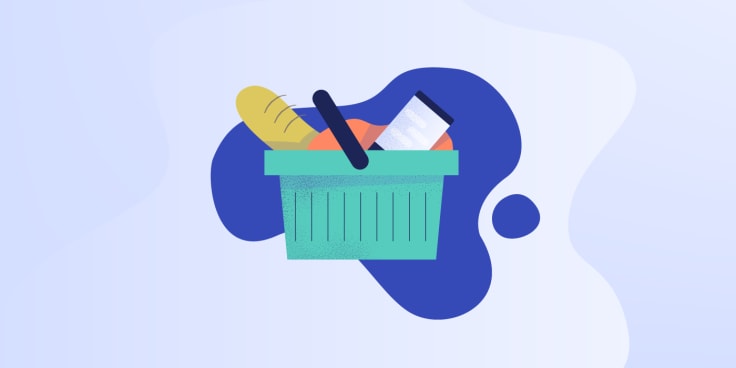
As an online store owner, you do everything you can to make sure that your business is running smoothly. You make sure the best photos of your products are taken. You craft the best product descriptions. And you make your site load times quick and navigation easy. Despite reaching your target sales figures for the month, you know that you could still do better.
A Baymard Institute study analyzing 37 different online shops found that close to 70% of shopping carts are abandoned. This means that for every three successful transactions, there are seven more that could have also been pushed through. Which means that you’re missing out on the opportunity to triple your revenue.
Reasons for Online Cart Abandonment
Before trying to prevent it, it’s important to understand why people abandon their shopping carts.
The most common cart abandonment reasons include:
- The shopper cannot afford the product
- High shipping costs
- Slow or non-functioning website
- Complicated checkout process
- Being forced to create an online account
- Simply window shopping
- Reconsidering a product
- Lack of payment options
- Security concerns
Expensive shipping is the top reason why shopping carts are abandoned (63%). And there are those that abandon their shopping carts simply because they are online window shopping (57%).
A potential solution to the first problem? Incorporate shipping costs into the price of your products to encourage more sales.
There’s a way to convert people with the second classification to become buyers. You can give them a little nudge using abandoned cart emails.
What are Abandoned Cart Emails?
Abandoned cart emails are emails automatically sent to users that remind them of the items that they put in an online shopping cart but didn’t buy.
In some situations, you can surmise that some shoppers didn’t abandon their shopping carts on purpose. Maybe they experienced an error with checkout or simply got distracted, for instance.
The reason behind cart abandonment could be anything. Regardless of the reason, abandoned cart emails are very effective in increasing sales revenues.
- According to Salecycle, 28.3% of ecommerce revenue comes from abandoned cart emails.
- Some brands have even reported that their revenues from email increased from 8% to 20% after sending abandonment emails.
The ideal abandoned cart email is set up to send shoppers an email with a link that lets them pick up where they left off. So they don’t have to go through the whole process of finding the product and registering to make a purchase.
However, there’s one thing you need to ensure before focusing on crafting the perfect abandoned cart email. Your checkout process should be optimized and functioning well.
Crafting the Perfect Abandoned Cart Email
Businesses pull out all the stops to get people to convert. Abandoned cart emails have the science of timing and psychological triggers down pat.
Here are some of the elements that make up the perfect abandoned cart email:
Timing and Frequency is Everything
Your abandoned cart email should be timely, first of all. You want your customers to remember going to your website and what they were shopping for.
Consider sending your first abandoned cart email 60 minutes after a customer leaves your ecommerce store. So their shopping activities would still be fresh in their mind. GoDaddy suggests sending it within 15 minutes of abandoning the cart, which can get you 3x more conversions than if you send it after an hour.
Follow the lead of ecommerce shops such as TOMS or Patagonia. Their first abandoned cart emails are simple, staying true to the brand voice and reminding customers of items left in their carts.
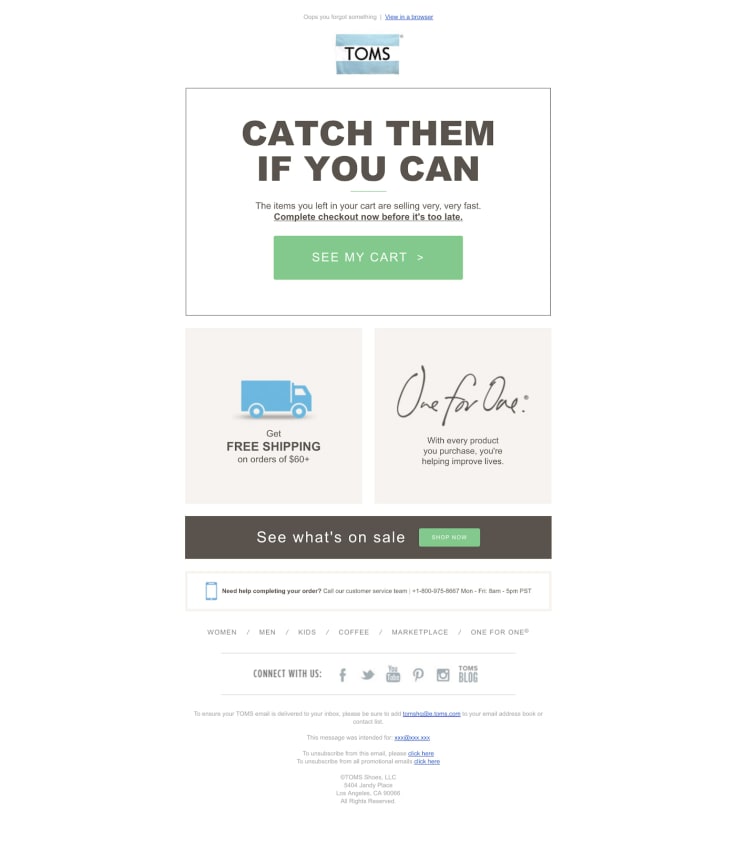
Frequency of emails is another important consideration. You should aim to send a total of at least three abandoned cart emails, with the second reminder coming in after 24 hours.
Maybe you're not convinced by a multiple abandoned cart email strategy. But did you know that 72% of those that ended up converting from their abandoned cart did so within the first 24 hours? And 23% converted after the first 24 hours. The second email reminder might include a limited-time discount code to incentivize a purchase.
Send the third abandoned cart reminder after 72 hours. This email should be the last in your abandoned cart email sequence. It should remind your customer about their last chance to enjoy their discount before it expires.
A few other things to consider:
- Configure your abandoned cart email sequences so that they don't send if/after the customer has already converted.
- Use A/B testing to determine which emails are most effective with your audience. Do this to test if certain emails get higher open and click-through rates. For instance compare the click-through and open rates for emails offering 10% discount vs 20% discount. You can then optimize your strategy accordingly.
Make an Offer
To get a customer to convert (especially a new one), businesses often offer promotions that include free shipping or discounts.
Free Shipping
Research shows that people appreciate free shipping more than price discounts. So offer this incentive to motivate shoppers to click through and finish their order.
This is consistent with the finding that customers are put off by expensive shipping as a reason why they don't end up buying online.
Discounts
Discounts are another incentive to get customers to push through with a purchase. Businesses usually send in coupon codes in the second or third abandoned cart email.
Just don't get into the habit of letting customers expect a coupon code from you every time they abandon their shopping carts. Segment your email so that only first time customers can get a limited-time coupon code to complete a purchase.
It is also suggested that you use autofill at checkout when shoppers click through from a relevant email with a coupon code. This will make the customer’s experience easy and seamless.
Additional Tips for Abandoned Cart Emails
Use the Perfect Subject Line
To get customers to open your message, your email subject line has to be intriguing and pique interest. You only have a few words to get the subscriber to open the email, so make sure it catches their attention.
Here are a few examples (you can find more at MailCharts.com):
Ziamond:
- Abandoned cart email #1: Oops, we noticed you forgot something
- Abandoned cart email #2: Was there a problem checking out?
TOMS:
- Abandoned cart email #1: Still interested?
- Abandoned cart email #2: Your TOMS are selling out fast
- Abandoned cart email #3: Still interested?
Rawlings Sporting Goods:
- Abandoned cart email #1: Forgot something? Complete your order today
- Abandoned cart email #2: Interested in 5% off your Rawlings gear?
Personalized Content
Customers are screaming for personalized content—they don't want to feel like any other customer; they want to be treated special.
You can make use of ecommerce personalization by making use of relevant customer shopping data. Implement it in simple ways such as offering discounts to high value carts. Or you can offer free shipping to those who abandoned carts due to high shipping costs.
For example, you can also mention what they were looking at, like Beardbrand did:
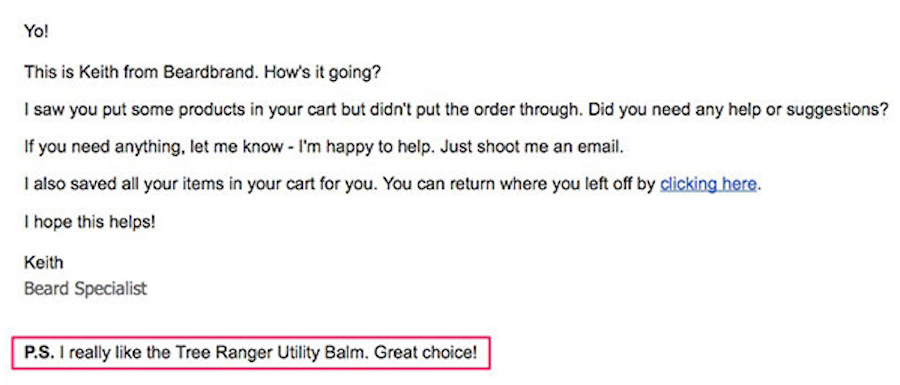
Highlight the Items in Their Cart
To assist with recall, you might opt to include a photo of the item being considered in your abandoned cart emails. You should also include a description and details of the item.
Here’s how Target used this principle to their advantage, also highlighting a price drop:

Include a Prominent CTA
Buying the product they left behind in their shopping cart is the only action you want your customers to take at this point. So highlight this particular action to ensure that they don’t miss it.
Like other CTAs, make it action-oriented, such as “Continue Shopping” or “Proceed to Checkout.” Or, have fun with it, like Lush:
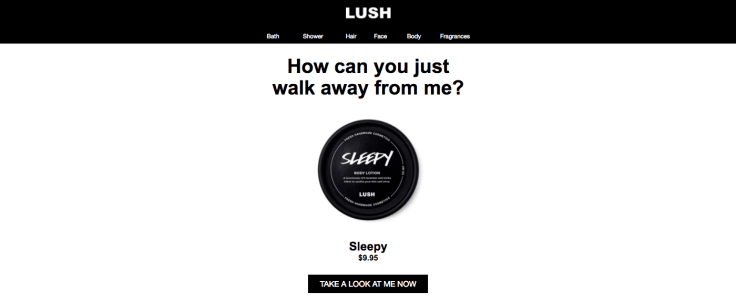
Optimize for Mobile
Over 50% of people access the internet via their mobile phones, so it must follow that more people access their emails on their mobile phones as well. Besides knowing this, mobile ecommerce sales in the US are projected to be up to $333.65 billion by 2021.
Upsell and Cross-Sell
The goal of abandoned cart emails is to get sales, and if you have a chance to sell more than what was in their cart, why not take it? You can upsell or cross-sell by offering related products or better/more expensive similar products.
Skillshare makes money from selling memberships. But they keep members by offering a constantly updated catalog of educational content. They send reminders about classes you’ve indicated an interest in. Their reminder emails also attempt to entice you back in with new, related options:

Product Reviews
People often trust peer recommendations more than they do with ads. So to push more sales and convince them to buy the product, you might add reviews to abandoned cart emails.
Or, embed a positive customer tweet, such as in this Grammarly email:
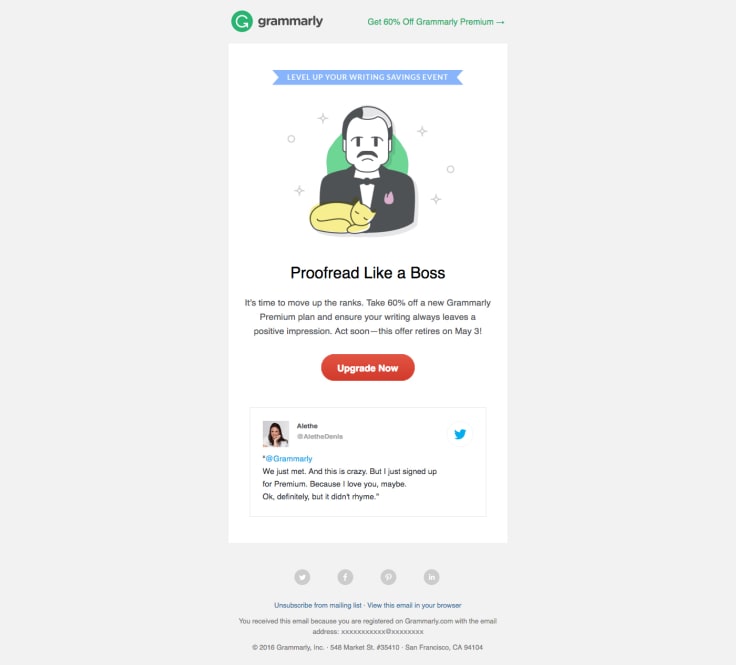
Survey
Ask your clients why they abandoned their cart to try and understand their behavior. These insights will help you create the best abandoned cart email and will help prevent abandoned carts in the first place.
Here’s how Erin Flynn made use of this concept for her membership website:
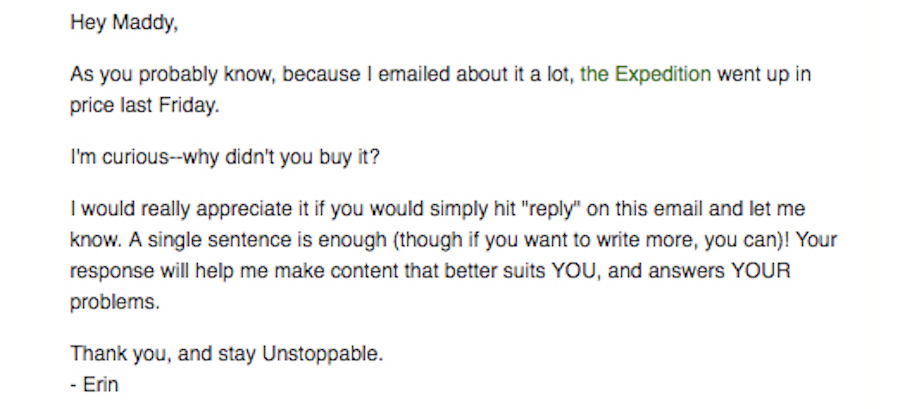
Creating abandoned cart emails
Abandoned cart emails help ecommerce businesses sell more. This is largely because there are twice as many people that abandon their carts than proceed to shopping.
There are various reasons as to why people abandon their shopping carts. Maybe the internet connection got cut, they were busy, or your website malfunctioned. Due to these reasons, the abandoned cart email, when sent in a timely manner, reminds them to reconsider.
The perfect abandoned cart email is visually appealing. It is begging to be opened and strikes an emotional and psychological cord at the same time. It also varies from business to business, so don't hesitate to do A/B testing. Good luck!
Get a glimpse into the future of business communication with digital natives.
Get the FREE report







Comments